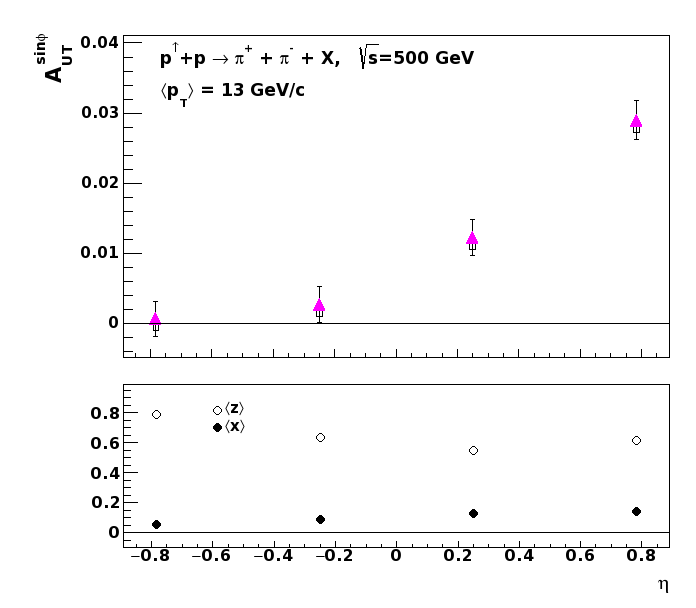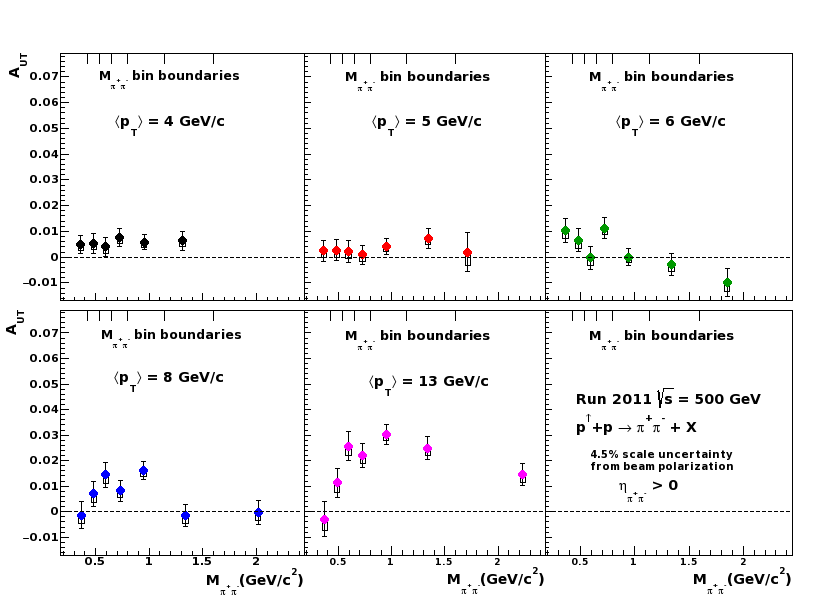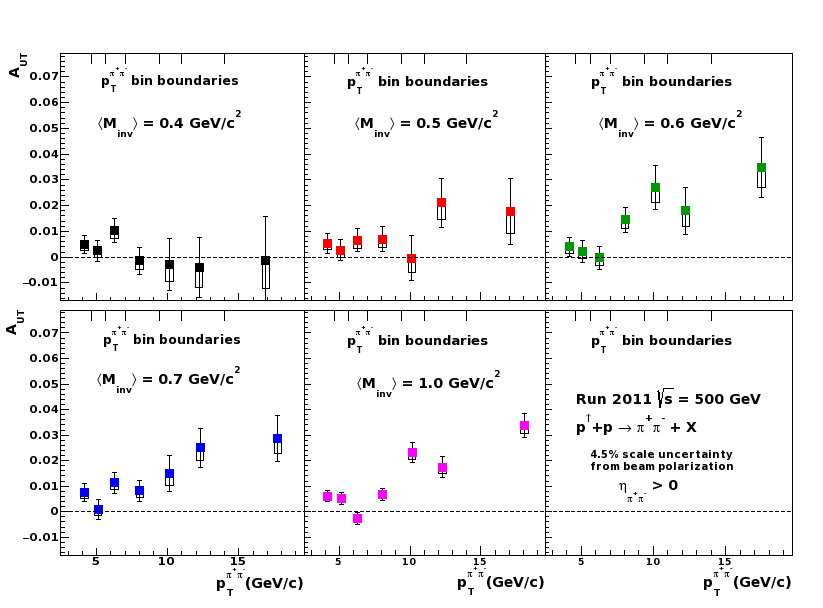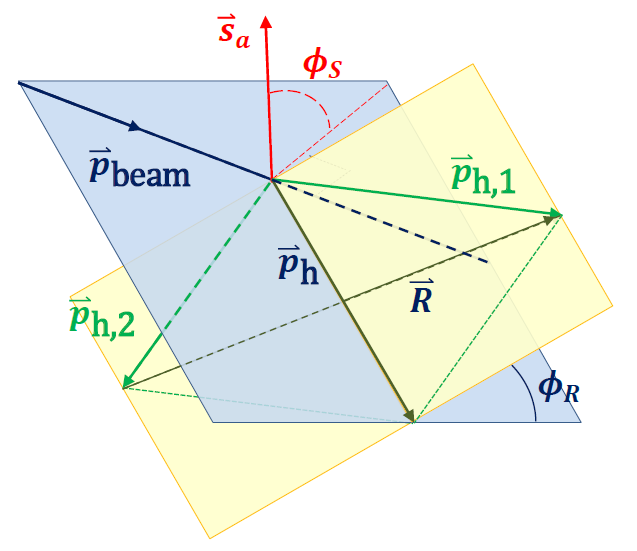Paper Proposal: 2011 IFF @ 500 GeV
Updated on Sun, 2015-11-01 22:17. Originally created by skoby on 2015-09-30 14:19.
Title
Transverse Spin Dependent Azimuthal Correlations of Charged Pion Pairs Measured in Polarized p+p Collisions at √s = 500 GeV
Target Journal
Physics Letters B
Abstract
The transversity distribution, which describes transversely polarized quarks in a transversely polarized nucleon, is a fundamental component of the current picture of the spin structure of the nucleon, and is only loosely constrained by existing semi-inclusive deep inelastic scattering data. The di-hadron interference fragmentation function, which describes the fragmentation of transversely polarized quarks, is expected to give rise to spin-dependent di-hadron correlations in polarized p+p collisions. The charge-ordered pion pair asymmetry measurement from √s = 500 GeV polarized p+p collisions at STAR is reported as a function of pion pair transverse momentum, invariant mass and pseudorapidity.
Principal Authors
Michael Skoby, Anselm Vossen (Indiana University--CEEM)
Figures
Figure 1: Asymmetry vs pair pseudorapidity for largest pair pT bin
Since valence quarks of the incident proton, described by transversity, have large x, transversity will be manifested in forward pion pairs, resulting in the significant rise of the asymmetry for increasing pair pseudorapidity in the highest pair pT bin in the top panel. Statistical uncertainties are error bars and the open rectangles below the data points are the asymmetric trigger bias uncertainties. In the bottom panel, kinematic variable x and z are shown.

Figure 2: Asymmetry vs invariant mass for 5 pair pT bins
A significant signal is seen in the highest pair pT bin for pair pseudorapidity > 0, with an enhancement near the rho mass at mid-invariant mass. This enhancement is expected from the transverse spin dependent IFF due to the interference of vector meson decays in a relative p-wave interfering with the non-resonant background in a relative s-wave. Statistical uncertainties are error bars and the open rectangles below the data points are the asymmetric trigger bias uncertainties. The invariant mass bin boundaries are shown at the top of each panel.

Figure 3: Asymmetry vs pair pT for 5 Minv bins
Statistical uncertainties are error bars and the open rectangles below the data points are the asymmetric trigger bias uncertainties. The pair pT bin boundaries are shown at the top of each panel.

Figure 4: Azimuthal Angle Diagram
The azimuthal angles in the scattering system used to calculate AUT, where the scattering plane is defined by the polarized beam direction, pbeam, and the direction of the total momentum of the pion pair, ph. The two-hadron plane is defined by the momentum vectors from each pion in the pair. The angle between the scattering plane and the polarization of the incident beam, Sa, is phiS. The angle between the scattering plane and the two-hadron plane is phiR, which is used to define phiRS = phiR-phiS.

Summary
STAR has measured the first charged-ordered di-pion correlation asymmetries in polarized p+p collisions at √s = 500 GeV. These data show high precision asymmetries at high pair pT and high invariant mass for pair pseudorapiditiy > 0. These measurements are at much higher Q2 and sample a different mixture of quark flavors than SIDIS. The results may be used to test universality of transverse polarization dependent quantities(SIDIS vs p+p).
Analysis Note
Paper Preview
Transverse Spin Dependent Azimuthal Correlations of Charged Pion Pairs Measured in Polarized p+p Collisions at √s = 500 GeV
Target Journal
Physics Letters B
Abstract
The transversity distribution, which describes transversely polarized quarks in a transversely polarized nucleon, is a fundamental component of the current picture of the spin structure of the nucleon, and is only loosely constrained by existing semi-inclusive deep inelastic scattering data. The di-hadron interference fragmentation function, which describes the fragmentation of transversely polarized quarks, is expected to give rise to spin-dependent di-hadron correlations in polarized p+p collisions. The charge-ordered pion pair asymmetry measurement from √s = 500 GeV polarized p+p collisions at STAR is reported as a function of pion pair transverse momentum, invariant mass and pseudorapidity.
Principal Authors
Michael Skoby, Anselm Vossen (Indiana University--CEEM)
Figures
Figure 1: Asymmetry vs pair pseudorapidity for largest pair pT bin
Since valence quarks of the incident proton, described by transversity, have large x, transversity will be manifested in forward pion pairs, resulting in the significant rise of the asymmetry for increasing pair pseudorapidity in the highest pair pT bin in the top panel. Statistical uncertainties are error bars and the open rectangles below the data points are the asymmetric trigger bias uncertainties. In the bottom panel, kinematic variable x and z are shown.

Figure 2: Asymmetry vs invariant mass for 5 pair pT bins
A significant signal is seen in the highest pair pT bin for pair pseudorapidity > 0, with an enhancement near the rho mass at mid-invariant mass. This enhancement is expected from the transverse spin dependent IFF due to the interference of vector meson decays in a relative p-wave interfering with the non-resonant background in a relative s-wave. Statistical uncertainties are error bars and the open rectangles below the data points are the asymmetric trigger bias uncertainties. The invariant mass bin boundaries are shown at the top of each panel.

Figure 3: Asymmetry vs pair pT for 5 Minv bins
Statistical uncertainties are error bars and the open rectangles below the data points are the asymmetric trigger bias uncertainties. The pair pT bin boundaries are shown at the top of each panel.

Figure 4: Azimuthal Angle Diagram
The azimuthal angles in the scattering system used to calculate AUT, where the scattering plane is defined by the polarized beam direction, pbeam, and the direction of the total momentum of the pion pair, ph. The two-hadron plane is defined by the momentum vectors from each pion in the pair. The angle between the scattering plane and the polarization of the incident beam, Sa, is phiS. The angle between the scattering plane and the two-hadron plane is phiR, which is used to define phiRS = phiR-phiS.

Summary
STAR has measured the first charged-ordered di-pion correlation asymmetries in polarized p+p collisions at √s = 500 GeV. These data show high precision asymmetries at high pair pT and high invariant mass for pair pseudorapiditiy > 0. These measurements are at much higher Q2 and sample a different mixture of quark flavors than SIDIS. The results may be used to test universality of transverse polarization dependent quantities(SIDIS vs p+p).
Analysis Note
Paper Preview
»
- skoby's blog
- Login or register to post comments
